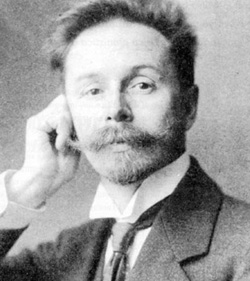Scriabin's Bridge

By Brian Parker
(February 2011)
Nineteenth-century Russian music was recklessly splattered over a canvas of nationalism, revolutionism, and progressivism. The brush was passed along from Mikhail Glinka, the first notable Russian classical composer, to "The Mighty Five," comprising Balakirev, Cui, Mussorgsky, Borodin, and ringleader Rimsky-Korsakoff. This group would complete the blatantly anti-European brushstrokes of Slavic music. The leftover drippings would become the synesthetic color-tones of Alexander Scriabin's compositional style.Russian music owes its distinctive sound to the strict filtering of art that began during the sixteenth century, with the tsar's barring of all things Western. As Europe developed an elaborate musical tradition, Russia limited itself to religious and folk music. A resistance to globalization along with general despotism likely accounts for the widespread mental instability, alcoholism, and rebelliousness of the Slavic lands. But it was this same resistance that allowed Russia to preserve itself as an untouched petri dish for its growing musical culture.
Alexander Scriabin is credited with bridging the gap between tonal and atonal music, but just as importantly, he bridged a gap between Western and Russian music. "The Five" conceived Russian classical composition in opposition to Europeanization. Tchaikovsky absorbed Western harmony and based his most famous pieces on it. Scriabin lies somewhere between these two diametrically opposed styles, and slightly off axis from any previously known harmony or form.
Works such as his etudes, his preludes, and his famous Fifth Sonata would draw on European romanticism and shed light on the musical future. While still constructed in sonata form, the Fifth Sonata strays away from any conventional musical boundaries with dark, low passages, remnants of Russian dance rhythms, and chromatic, atonal passages countering indescribable dissonances. The piece ends on an upper-register chord that must be undergirded by some calculated musical explanation, but leaves the listener waiting for a closing statement on a tonic that is barely identifiable.
Alexander Scriabin's messianic entry and exit into the physical world and the music world are strangely correlated with his interest in mysticism. Scriabin's religious direction is difficult to understand. He was fascinated with the ideas of theosophy and more than once appeared to hint at his own divine power. He wrote several journal pages that alluded to the "Man-God," and there are points where he addresses "the world" in a commanding, if poetic, voice. One notebook includes a prophecy that would later become essential to his music: "The deed of Prometheus, the word of Christ, I am come to give you the secret of life and death." Scriabin's battle with nervous breakdowns and mental illness seems to place him at the short end of a power struggle with God, but his beliefs gave him the freedom to imagine a godly, prophetic level in a personal spiritual spectrum.
The fourth symphony, Poem of Ecstasy, is bluntly erotic, though it is unclear whether the ecstasy is physical or religious. Barely a sonata, the musical poem accompanies an equally erotic verbal poem. These mirror each other until the final "orgasmic climax" of Le Poeme, which as originally written declares, "I am God." It sections include (1) his soul in the orgy of love, (2) the realization of a fantastic dream, and (3) the glory of his own art. The conductor's score includes dynamic instructions such as "with a sensual pleasure even more rapturous" and "as languid as possible," stressing how sexual Scriabin intended the piece to be. Scriabin flows through several emotional sections of this piece, which makes it difficult to follow without the help of a listing or score.
The messianic pretension of the composer's life inspired The Mysterium, an unfinished work intended to last seven days and precede the end of the world. His last symphony, Prometheus, is based on musical sets and pitch classes, a mathematical, orchestral color-by-number. Its central theme is the "Mystic chord," a signature series of six notes that were meant to expose man to hidden divinity. The piece was intended to be played with accompanying visual effects, making use of the "light-organ," a keyboard whose pitches triggered various ordered colors. This serial synesthesia became one of Scriabin's claims to fame after his death.
Modern reinterpretations of Scriabin's work fluctuate between technical replications of the visionary's intentions and loosely derivative pieces based on the performer's personal understanding of the work. In the case of pianist Eteri Andjaparidze and lighting engineer and artist Jennifer Tipton, reinterpreting Scriabin is a contextual challenge. Tipton says that recreating Scriabin's "light-organ" was not the basis of the hypnotizing performance of Spectral Scriabin at the Baryshnikov Arts Center in Manhattan last October 26, but that she was using color to interpret the pieces based on her own intuition. Andjaparidze and Tipton worked to create a climactic program of various Scriabin pieces that would allow brief emotional sensations to arise in the listener. These sensational morsels of music are short symbolic poems, as opposed to Scriabin's epic symphonic poems. Andjaparidze claims that Scriabin "does not allow" her to work simultaneously on other pieces. His work is so egocentric and so consuming that often his smaller works are mistakenly interpreted as being less enrapturing. Spectral Scriabin, a sensory and trance-inducing performance, only bscrapes the tip of the compositional iceberg that is Scriabin's most underrated work.
Alexander Scriabin ushered in the minimalism of John Cage, Steve Reich, and Philip Glass. But unlike these composers' approach to defying theory simplistically, Scriabin was expanding a musical language that complicated Bachian counterpoint and the sonata form of Mozart. His etudes were not only challenging exercises, they were short works that foreshadowed his masterpieces. Scriabin's musical paintings could be considered aural equivalents of the pointillism of the late nineteenth century--painstakingly placed dots on the canvas seem abstract when viewed up close, but form a cohesive whole when viewed from afar.